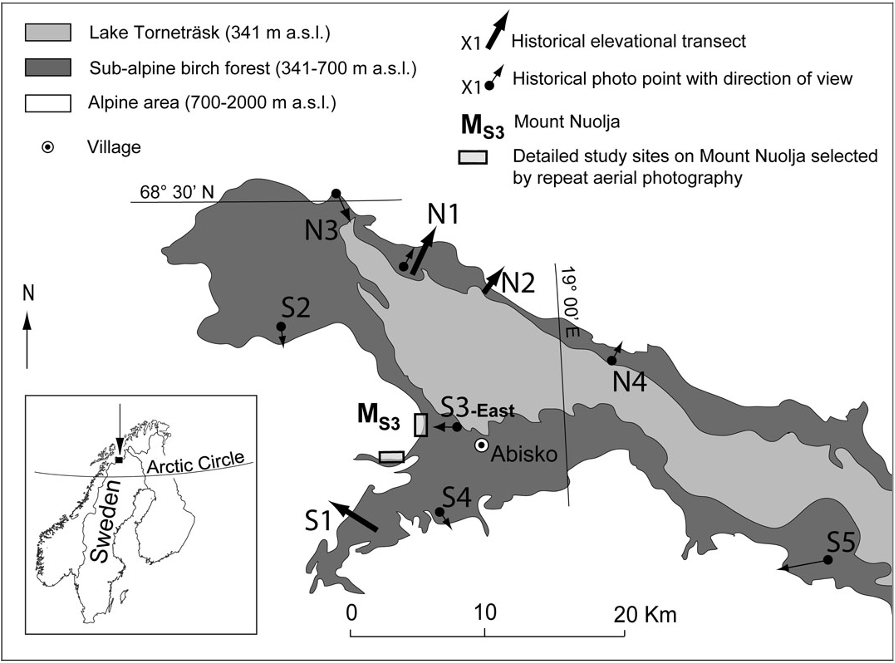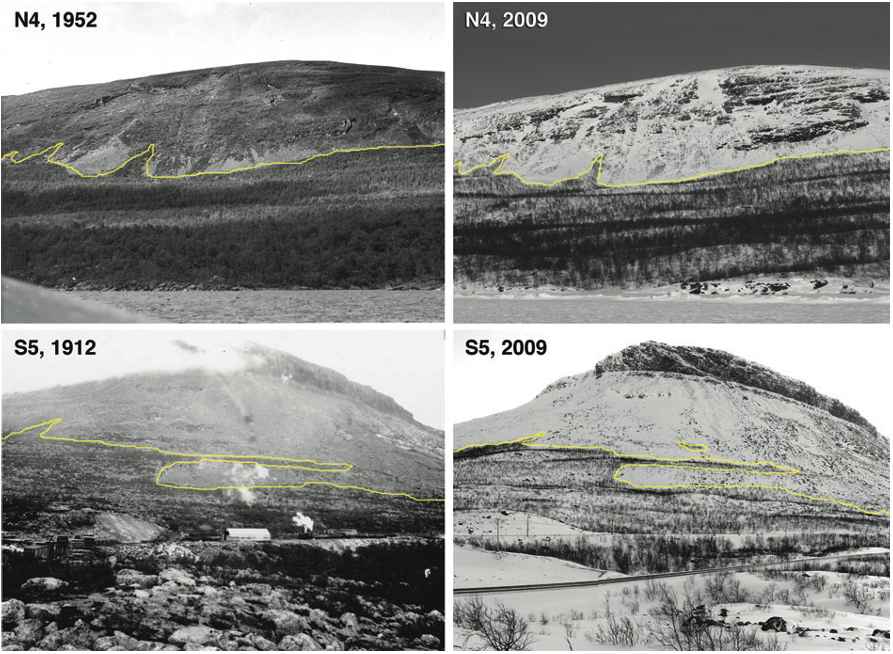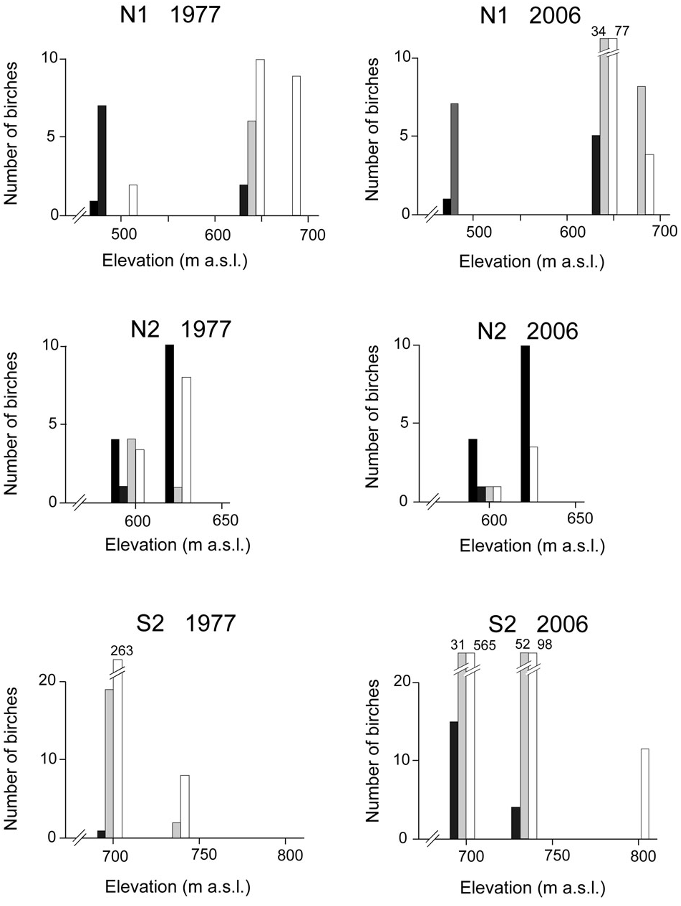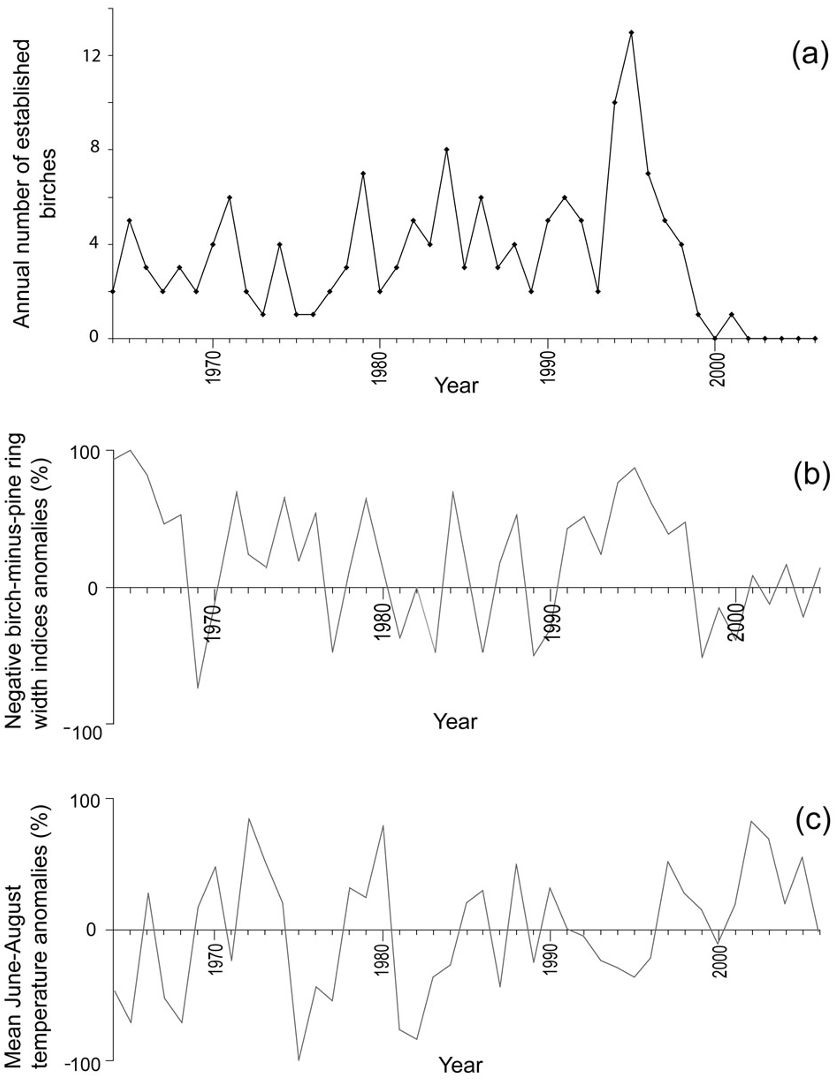
biblio.ugent.be
The UGent Institutional Repository is the electronic archiving and dissemination platform for all
UGent research publications. Ghent University has implemented a mandate stipulating that all
academic publications of UGent researchers should be deposited and archived in this repository.
Except for items where current copyright restrictions apply, these papers are available in Open
Access.
This item is the archived peer-reviewed author-version of:
A century of tree line changes in sub-Arctic Sweden shows local and regional variability and only a
minor influence of 20th century climate warming
Van Bogaert, R.; Haneca, K.; Hoogesteger, J.; Jonasson, C.; De Dapper, M.; Callaghan, T.V.
In: Journal of Biogeography, 38 (5), 907-921, 2011.
doi: 10.1111/j.1365-2699.2010.02453.x
To refer to or to cite this work, please use the citation to the published version:
Van Bogaert, R.; Haneca, K.; Hoogesteger, J.; Jonasson, C.; De Dapper, M.; Callaghan, T.V.
(2011). A century of tree line changes in sub-Arctic Sweden shows local and regional
variability and only a minor influence of 20th century climate warming. Journal of
Biogeography 38 (5), 907-921. doi: 10.1111/j.1365-2699.2010.02453.x

1
A century of tree line changes in sub-Arctic Sweden shows local and regional
variability and only a minor influence of 20
th
century climate warming
Rik Van Bogaert
1,2*
, Kristof Haneca
3
, Jan Hoogesteger
4
, Christer Jonasson
5,6
, Morgan
De Dapper
2
and Terry V Callaghan
5,7
1
Flanders Research Foundation (FWO); Egmontstraat 5, B-1000 Brussels, Belgium
2
Department of Geography, Ghent University, Krijgslaan 281 S8, B-9000 Ghent, Belgium
3
Flemish Heritage Institute, Koning Albert II-laan 19 bus 5, B-1210 Brussels, Belgium,
formerly Laboratory of Wood Technology, Ghent University Coupure Links 653, 9000
Ghent, Belgium
4
Department of Forest Sciences, University of Helsinki, PO Box 27, FI-00014 Helsinki,
Finland
5
Abisko Scientific Research Station, Royal Swedish Academy of Sciences, SE-98107
Abisko, Sweden
6
Department of Physical Geography, Uppsala University, S-75122 Uppsala, Sweden
7
Department of Animal and Plant Sciences, University of Sheffield, Western Bank, Sheffield
S10 2TN, UK
*Corresponding author: Address: Yzerhand 85, B-9120 Beveren, Belgium.
rikvanbogaert@gmail.com
Running head: Twentieth century tree line changes in Swedish sub-Arctic

2
Abstract 1
Models project that climate warming will cause the treeline to move to higher 2
elevations in alpine areas and more northerly latitudes in Arctic environments. We 3
aimed to document changes or stability of the treeline in a sub-Arctic model area at 4
different temporal and spatial scales, and particularly to clarify the ambiguity that 5
currently exists about treeline dynamics and their causes. The study was conducted in 6
the Torneträsk area in northern Sweden where climate warmed by 2.5 ˚C between 7
1913 and 2006. Mountain birch (Betula pubescens ssp. czerepanovii) sets the alpine 8
treeline. We used repeat photography, dendrochronological analysis, field 9
observations along elevational transects and historical documents to study treeline 10
dynamics. Since 1912, only four out of eight treeline sites had advanced: on average 11
the treeline had shifted 24 m upslope (+0.2 m year
-1
assuming linear shifts). 12
Maximum treeline advance was +145 m (+1.5 m year
-1
in elevation and +2.7 m year
-1
13
in actual distance), whereas maximum retreat was 120 m downslope. Counter-14
intuitively, treeline advance was most pronounced during the cooler late 1960s and 15
1970s. Tree establishment and treeline advance were significantly correlated with 16
periods of low reindeer (Rangifer tarandus) population numbers. A decreased 17
anthropozoogenic impact since the early 20
th
century was found to be the main factor 18
shaping the current treeline ecotone and its dynamics. In addition, episodic 19
disturbances by moth outbreaks and geomorphological processes resulted in descent 20
and long-term stability of the treeline position, respectively. In contrast to what is 21
generally stated in the literature, this study shows that in a period of climate warming, 22
disturbance may not only determine when treeline advance will occur but if treeline 23
advance will occur at all. In the case of non-climatic climax treelines, such as those in 24
our study area, both climate-driven model projections of future treeline positions and 25

3
the use of the treeline position for bioclimatic monitoring should be used with caution.26
27
28
Key words: climate warming, dendrochronology, herbivory, human impact, mountain 29
birch, reindeer, sub-Arctic, Sweden, tree line, tree line causes 30
31
32
33
34
35
36
37
38
39
40
41
42
43
44
45
46

4
Introduction 47
Mean annual temperatures have risen globally over the past century, with the most
48
pronounced and rapid changes at high elevations and latitudes (ACIA, 2005). As the
49
location of elevational and polar treelines is mainly caused by heat deficiency, in the
50
Northern Hemisphere climate warming is expected to cause treelines to advance to
51
higher elevations and more northerly latitudes (Harsch et al., 2009). Indeed, modern
52
evidence for such relocations exists and these have been explicitly or implicitly
53
related to recent climate warming (Shiyatov et al., 2007; Kullman and Öberg, 2009).
54
However, in many circumpolar and high-elevational areas the position of the treeline
55
has not changed (Masek, 2001; Holtmeier et al., 2003; Payette, 2007; Van Bogaert et
56
al., 2007) or has even retreated (Vlassova, 2002; Dalen and Hofgaard, 2005; Kullman,
57
2005; Cherosov et al., 2010).
58
Treeline heterogeneity increases from global to regional, to landscape and to local
59
scales of analysis (Callaghan et al., 2002). Moreover, the factors controlling the
60
position and structure of the treeline are highly scale-dependent and vary from place
61
to place (Sveinbjörnsson et al., 2002). Individual trees and the forest system may
62
respond differently to change; warming may increase tree growth, while at the same
63
time seedling survival may be reduced because of water stress brought about by
64
greater evapotranspiration and drying of the uppermost soil. Furthermore, the time-
65
scale of a study influences outcomes because it determines the processes and
66
responses that can be studied. There are short-term responses (defined as a year or
67
less and reflected in individual tree growth), medium-term responses (some years to a
68
few decades and reflected in changing survival rates of seedlings and altered tree
69
physiognomy) and long-term responses (several decades to centuries and reflected in
70
a general treeline advance or retreat) (Holtmeier and Broll, 2005).
71





